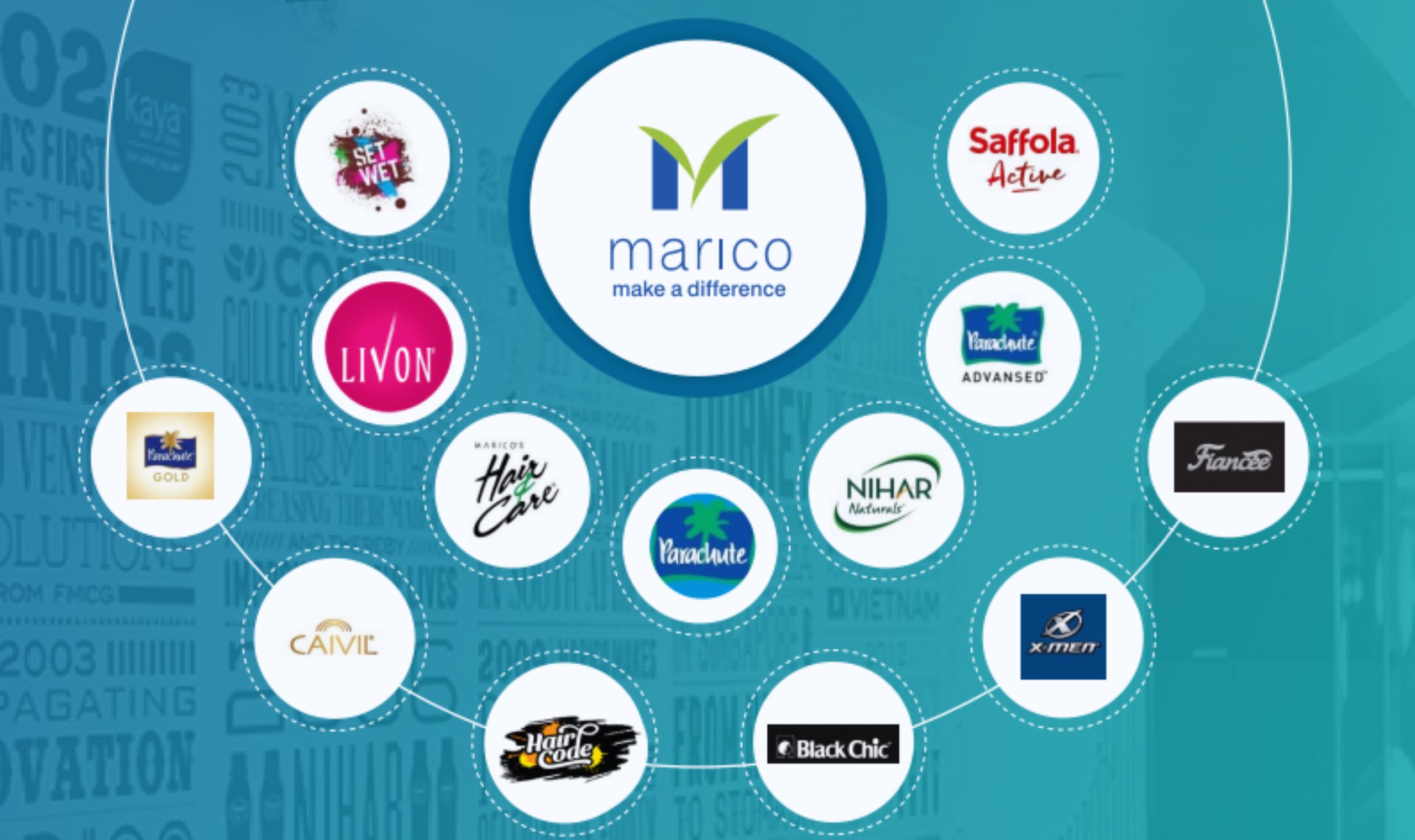In the world of Fast Moving Consumer Goods, companies should continuously face fluctuating input costs, shifting consumer preferences, and fierce competition to ensure the sustainability of their profit margins. Notwithstanding those above, in the sphere of the FMCG sector in India, Marico has recently published its third-quarter business update for FY25 and highlighted how rising input costs impact the business and how the management is striving to maintain expansion combined with profitability.
On January 3, Marico gave a preview that indicated that margins would come in lower than expected, jolting the market. Input costs, which were mainly impacting the company from the side of key raw materials like copra used in the flagship Parachute Coconut Oil brand and vegetable oils, were stated to have a pressure effect on its margins. Despite such headwinds, Marico is still expansion and brand-building-focused, as are two vital parts of the long-term growth strategy.
This blog discusses Marico’s current market performance, its challenges, and the strategies it adopts to mitigate these challenges and drive future growth. We will dive into the specifics of its third-quarter update, including the impact of rising input costs, the company’s consumer franchise expansion, and its overall revenue growth. We will also examine how the company’s brands, such as Parachute Coconut Oil, Saffola Oil, and its value-added hair oil segment, are performing in this competitive and cost-sensitive market.
The Rise of Input Costs and Its Impact on Margins
Being one of the largest FMCG companies in India, its margins are more or less sensitive to the increase in the prices of its raw materials. The update of the company in the third quarter stated that input costs are on the rise, mainly because of copra and vegetable oils, which significantly press the margins.
Copra, being the dried meat of coconut for producing coconut oil, and vegetable oils are also a significant portion of Marico’s most well-known products in the market- ParachuteCoconut Oil and Saffola Oil. Supply chain disruptions and increasing global demand resulted in inflationary pressures, further driving up raw material costs on which the increased demand has raised its head to dent the bottom line of profits of the firm.
Marico management has admitted that the current environment of high input costs may lead to a bigger-than-expected contraction in margins compared to the previous year. This is worsened by the fact that the company is looking to expand its consumer franchise, which requires a huge investment in both product innovation and marketing. This has led to concerns that Marico may face a more challenging quarter than initially anticipated.
Market Response and Stock Performance
Marico declined by over 4% on 6 January. Investors reacted to the updated outlook in margins by the company. Despite its significant gains in brand building and expansion in the consumer base, the impact of rising input costs has affected the market instantly.
This shows how sensitive FMCG stocks are to the decline in profitability, especially with the increase in input costs. In a sector characterized by relatively low margins, the squeeze on those margins is bound to have an amplified impact on the stock price.
However, despite this short-term challenge, analysts are divided on the company’s prospects. CLSA, for example, expects Marico to report a modest operating profit growth of 4.8% year-over-year (YoY), a figure that reflects the current margin pressures. Still, the brokerage remains optimistic about the company’s ability to grow its top line, forecasting mid-teens revenue growth for Q3, with full-year revenue growth expected to remain in double digits.
1. Brand Performance: Resilience Amid Challenges
While rising input costs have posed challenges for Marico, its flagship brands continue to hold their ground within a challenging pricing scenario. Let us see how some of the significant product segments performed during the third quarter for Marico:
2. Parachute Coconut Oil: Consistent Performer
Parachute Coconut Oil, one of Marico’s most iconic products, continues to show resilience despite the significant rise in copra prices. The brand achieved low double-digit revenue growth during the quarter, supported by another price increase in December to counter the persistently high costs of copra. Despite this price hike, Parachute Coconut Oil’s performance remained strong, although volumes declined sequentially. This highlights the brand’s strength in maintaining customer loyalty and demand, even when faced with higher prices.
Marico can pass on price hikes without losing growth in revenue. This is because of the brand equity it has achieved over decades. Now, it will be interesting to see if Marico will be able to balance the hike in prices with volume growth since sustained price hikes tend to impact consumers’ buying behaviour.
3. Saffola Oil: Growth Continues Despite Price Increases
Saffola Oil is another core brand for Marico, which has seen steady growth despite the inflationary pressures in vegetable oil prices. The brand delivered high double-digit revenue growth in Q3, a testament to its strong position in the market and its ability to pass on higher costs to consumers through price hikes.
Although price increases have been a prime mover of revenue growth, Saffola Oil needs to perform well in the market without large volume declines. Edible oil is a very price-sensitive product category, so Marico has to be extremely cautious with price increases going forward to maintain its leadership position.
4. Value-Added Hair Oils: Recovery in Premium Segments
The value-added hair oil segment, which houses brands like Hair & Care and Nihar Naturals, reported a marginal volume decline during the quarter, mainly on account of competitive pressures. However, premium and mid-range hair oil segments have performed well, offsetting volume loss in lower-priced segments.
Marico’s premiumization focus, especially in the hair oil category, appears to be yielding fruit as consumers increasingly demand higher-quality, more effective products. The challenge for Marico in this category will be to continue expanding its premium offerings while maintaining growth in the mass-market segment.
Growth in Marico’s Other Segments: Foods and Digital-First Brands
Apart from its core brands in the edible oils and hair care segments, Marico has also been expanding into other categories such as foods and digital-first brands. These newer segments have shown robust growth, contributing positively to the company’s overall performance.
The foods division, including brands like Saffola Oats and Saffola Masala Oats, continues to reap the benefits of rising consumer demand for healthier and more convenient food options. It has been able to capitalize on the rising trend of health-conscious eating, which has accelerated with the COVID-19 pandemic.
Digital-first brands, which are more focused on e-commerce and direct-to-consumer sales channels, have also experienced growth. These brands are well-positioned to take advantage of the growing digital shopping trend, which has been particularly important in the post-pandemic world.
Strategic Focus: Expansion and Brand Building
Despite the challenges at the core, Marico seems to be moving in the long term with expansion in its consumer franchise and continued investments in the building of bits and. This entails both organic and inorganic routes through product innovation and the launching of new products and inorganic through targeted acquisition and joint ventures.
The company has made considerable investments in marketing and advertisement to create brand equity and widen the consumer base. In the long run, this should well pay off especially with Marico continuing to strengthen its presence in emerging markets and new categories.
Outlook and Conclusion
In conclusion, Marico’s third-quarter update reflects the company’s challenges and opportunities in the increasingly competitive and cost-sensitive market. Rising input costs, mainly in copra and vegetable oils, have created pressure on the margins of the company. However, Marico’s core brands remain resilient, as Parachute Coconut Oil, Saffola Oil, and the value-added hair oils segment maintain solid performance.
Looking ahead, Marico is likely to continue facing margin pressures in the near term as input costs remain elevated. However, the company’s focus on brand building, consumer franchise expansion, and strategic investments in new segments such as foods and digital-first brands position it well for long-term growth. Analysts remain cautiously optimistic about Marico’s ability to navigate the challenges it faces, with revenue growth expected to remain strong in the mid to high single digits for the full year.
Marico’s strategy of balancing price hikes with volume growth, while expanding into new product categories, will be key to its continued success in the competitive FMCG sector. If the company can effectively manage its costs, maintain strong brand equity, and leverage emerging growth opportunities, it should be well-positioned for future success.
Marico is thus a good play for investors from a long-term perspective in FMCG, while short-term fluctuations in margins do pose a risk. But still, the long-term outlook bodes well because of its solid track record of performance, brands, and continued innovation.















0 Comments